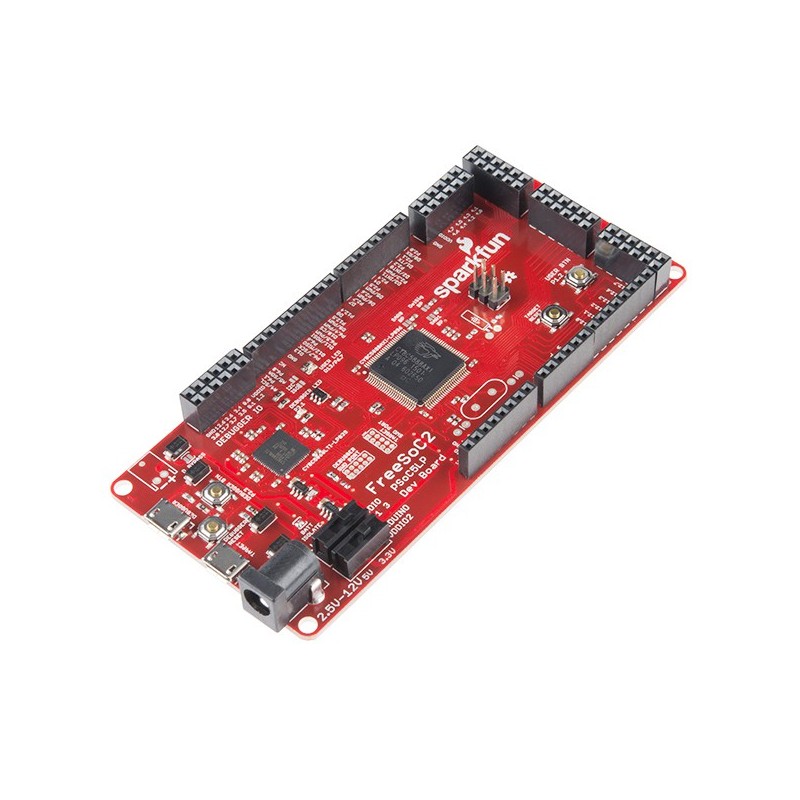- Obecnie brak na stanie






Oparta na układach PSoC5LP (ARM Cortex-M3) CY8C5868LTI-LP039 oraz CY8C5888AXI-LP096 z pamiecią Flash 256 kB, 64 kB SRAM i 2 kB EEPROM. Programowanie w standardowym IDE Arduino oraz możliwość korzystania z tych samych przykładów, bibliotek oraz shieldów co Arduino Uno. DEV-13229
FreeSoC2 Development Board - PSoC5LP
Description:
This is the FreeSoC2 Development Board, SparkFun’s take on the PSoC5LP ARM Cortex. The PSoC (Programmable System on a Chip) brings together features of the programmable devices and microcontroller-type systems on chips into one package. By placing a programmable fabric between the peripherals and the pins, the FreeSoC2 allows any function to be routed to any pin! Moreover, the on-board PSoC includes a number of programmable blocks which allow the user to define arbitrary digital and analog circuits for their specific application.
SparkFun’s FreeSoC2 board has two processors on-board: a CY8C5868LTI-LP039 and a CY8C5888AXI-LP096. The former serves as a debugger/programmer for the latter, which is the target upon which your application code will be installed. Both parts contain a Cortex-M3 processor core, 256kB of flash memory, 64kB of SRAM, and 2kB of EEPROM. The only significant difference between the two are package size and clock speed. The target is in a TQFP-100 package which provides 72 IO pins versus the debugger’s QFN-68 package and 48 IO pins, and the target can operate at 80MHz versus the debugger’s 67MHz limit. Additionally, the FreeSoC2 can support 5V and 3.3V IO voltages.
With a simple upload of new firmware, the Arduino core has been ported to the PSoC5LP, so you can write code for the board in the standard Arduino IDE. The board duplicates the functionality of an Arduino Uno R3’s various hardware peripherals on the pins, so many examples, libraries, and shields will work on this board. However, to get the most out of the device, you will need to use the PSoC Creator IDE (which is free of charge with no code limits from Cypress Semiconductor). Please keep in mind that the PSoC Creator software is Windows-only at this time.
Note: The FreeSoC2 Develpment Board is a collaboration with Jon Moeller. A portion of each sales goes back to him for product support and continued development.
Features:
Documents:
Producent BTC Korporacja sp. z o. o. Lwowska 5 05-120 Legionowo Polska sprzedaz@kamami.pl 22 767 36 20
Osoba odpowiedzialna BTC Korporacja sp. z o. o. Lwowska 5 05-120 Legionowo Polska sprzedaz@kamami.pl 22 767 36 20
Brak towaru
Brak towaru
Orange Pi One to komputer z SoC Alwinner H3 (4 rdzenie, Cortex-A7, Mali400MP2 GPU), ma 512 MB pamięci RAM i port Ethernet 100Mb/s. Dostępny jest jedno USB 2.0, złącze GPIO 40-pin oraz gniazdo kart micro-SD
Brak towaru
Zasilacz USB typu C PD o mocy 27 W. Dedykowany jest m.in. do minikomputerów Raspberry Pi 5. Ma wtyk europejski oraz obsługuje USB Power Delivery 5,1V/5A, 9V/3A, 12V/2,25A, 15V/1,8A. Waveshare PSU-27W-USB-C-EU
Brak towaru
UDOO-NEO BASIC to jednopłytkowy komputer z dwurdzeniowym procesorem ARM (Cortex-A9 i Cortex-M4 w jednym układzie), 512 MB pamięci RAM, system Linux, Wi-Fi.
Brak towaru
Addressable RGB 120-LED Strip, 5V, 2m (WS2812B)
Brak towaru
Zestaw zawierający sterownik silników w postaci płytki typu shield, dwa silniki, przewody oraz koła doskonale nadające się do budowy pojazdu opartego na Arduino. KIT-13201
Brak towaru
Brak towaru
Moduł umożliwia wyprowadzenie linii złącza GPIO Banana Pi na płytkę stykową. Zaprojektowany głównie do Banana Pi, ale może być dołączony także do innych modułów ze złączem dostosowanym do Banana Pi. Nazwa producenta: Banana pi - GPIO extend module, Rev.1.2
Brak towaru
Brak towaru
Brak towaru
Brak towaru
Brak towaru
Brak towaru
Olej parafinowy jest bezbarwnym i prawie bezwonny płynem o doskonałych właściwościach smarnych, stosowany do smarowania, ochrony przed korozją i konserwacji mechanizmów, szczególnie bezpieczny dla materiałów wrażliwych
Brak towaru
Brak towaru

Oparta na układach PSoC5LP (ARM Cortex-M3) CY8C5868LTI-LP039 oraz CY8C5888AXI-LP096 z pamiecią Flash 256 kB, 64 kB SRAM i 2 kB EEPROM. Programowanie w standardowym IDE Arduino oraz możliwość korzystania z tych samych przykładów, bibliotek oraz shieldów co Arduino Uno. DEV-13229
